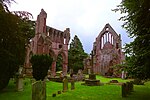Council Headquarters, Newtown St Boswells

The Council Headquarters is a municipal building in Newtown St Boswells, in the Scottish Borders council area in Scotland. It serves as the headquarters of Scottish Borders Council. Roxburghshire County Council built the first office on the site in 1896. The site later became that council's headquarters and meeting place in 1930, known as the "County Offices". A substantial new building was added in 1968, which forms the main part of the current building. Following local government reform in 1975 the building became the headquarters of the Borders Regional Council and was renamed "Regional Headquarters". When local government was reorganised again in 1996 the building became the headquarters of Scottish Borders Council and was renamed "Council Headquarters".
Excerpt from the Wikipedia article Council Headquarters, Newtown St Boswells (License: CC BY-SA 3.0, Authors, Images).Council Headquarters, Newtown St Boswells
B6398,
Geographical coordinates (GPS) Address Nearby Places Show on map
Geographical coordinates (GPS)
| Latitude | Longitude |
|---|---|
| N 55.57752 ° | E -2.67353 ° |
Address
Scottish Borders Council Headquarters
B6398
TD6 0PN
Scotland, United Kingdom
Open on Google Maps










